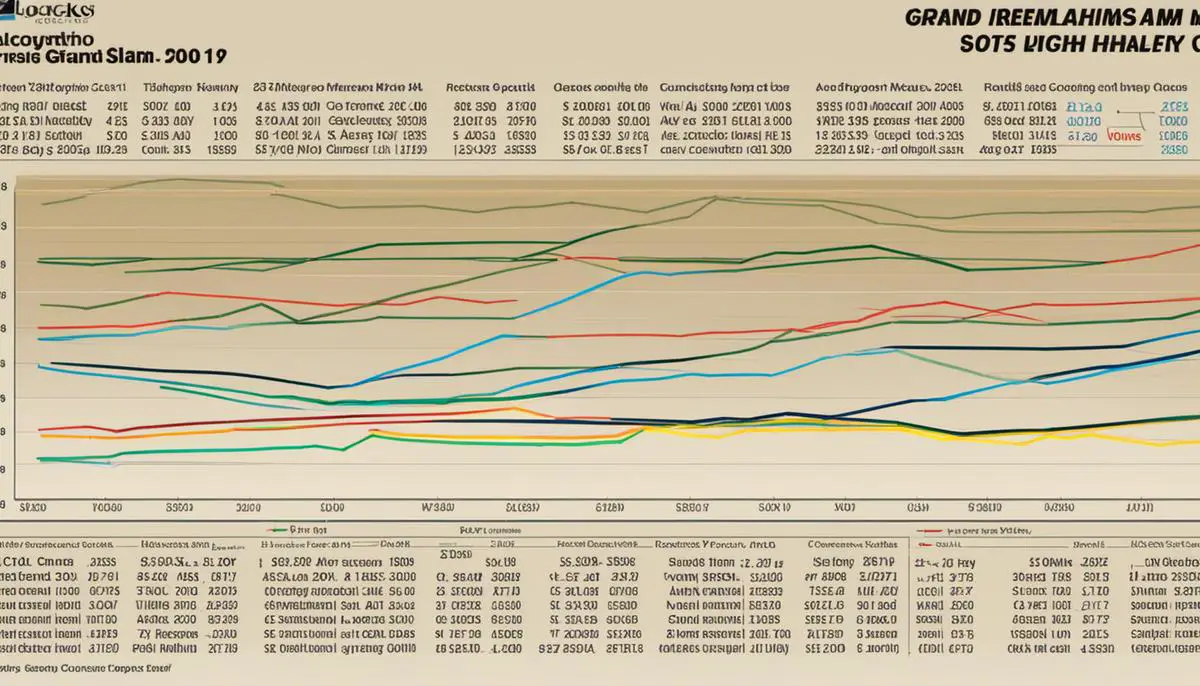Wielding immense skill and tenacity, Grand Slam winners are known to us as the titans of tennis and their victories are globally celebrated. But, there’s an accompanying narrative that remains somewhat understated—the sumptuous influx of wealth and the changes it brings along. Drawing attention to this, we’re going to decipher the financial milieu of these champions; encompassing their overall earnings, the complex and handsome world of endorsement deals, and the riveting lifestyle changes that come with such winnings.
Overall Earnings of Grand Slam Winners
Grand Slam Winners: Overall Earnings
From the Australian Open and Wimbledon to the French Open and the U.S. Open, Grand Slam wins are a pinnacle of achievement in the world of professional tennis. However, these victories come with more than just prestige – they often equate to significant financial returns. Cash rewards accompany each win, and bonuses accumulate for record-breaking performances throughout a player’s career.
Prize money for Grand Slam tournaments has increased dramatically over the years. For example, at the U.S. Open, the men’s and women’s singles champions each receive $3.8 million, a notable increase from the $150,000 winnings in 1968. In 2020, the Australian Open awarded winners $2.85 million, a rise from the $15,000 winners received in 1969. At Wimbledon, the monetary figure has increased from £200 in 1968 to £2.35 million in 2019. Meanwhile, at the French Open, the winner’s reward stood at $2.6 million in 2020, a significant rise from the $25,000 in 1968.
Gender disparity in Earnings
Historically, there’s been a considerable difference in the earnings of male and female Grand Slam winners. This fortune gap is due to the perception that men’s tennis is more popular and therefore generates higher revenue than women’s tennis.
However, the tables started turning in 1973 when the U.S Open became the first Grand Slam to offer equal prize money to men and women, following a protest led by tennis champion Billie Jean King. By 2007, all four Grand Slam tournaments had introduced gender pay equality. Today, men and women players receive equal prize money in all the four Grand Slam tournaments.
The Impact of Bonuses and Endorsements
Beyond the baseline prize money, many top-tier players enjoy substantial incomes from endorsements and bonuses, often far outstripping their on-court earnings. Roger Federer, for instance, has made more than $100 million in career prize money but has earned several times that amount from endorsements with companies such as Rolex, Mercedes-Benz, and Credit Suisse. Furthermore, performance bonuses offered by sponsors can significantly inflate a player’s earnings, particularly if they consistently perform well at Grand Slam tournaments.
Additionally, players make money from exhibition matches played outside the tournament circuit and appearance fees for participating in smaller tournaments. These extracurricular activities compound their annual income and have immense contributions to the total earnings of Grand Slam winners.
The Evolution of Income for Grand Slam Winners
The income landscape for Grand Slam winners has gone through a significant transformation over the years, supplemented notably by inflation, more profitable broadcast contracts, and the sport’s growing global interest. For example, the total prize money at Wimbledon in 1968 amounted to £26,150 (roughly $34,000). Today, that figure has skyrocketed to £38 million (approximately $50 million).
This exponential escalation of winnings not only signifies the commercial growth of tennis over time but also reflects the rise in societal disposable income and propensity to invest in sports. Given these factors, the earnings of Grand Slam winners are expected to continue their upward trajectory in the foreseeable future.
Although the COVID-19 pandemic has led to a temporary drawdown in awards due to the lack of match attendance revenue, lingering hopes of the return of live spectators fuel the anticipation that this will restore, and even possibly enhance, prize earnings in the not-too-distant future.

Endorsement Deals and Sponsorships linked to Grand Slam wins
The Essence of Endorsement Agreements and Sponsorships in Raising Tennis Stars’ Earnings
While Grand Slam winners do command hefty sums of money in prize winnings, it is the endorsement agreements and sponsorships that are the major breadwinners for these athletes. The allure of affiliating high-profile brands with these champions often allows the athletes to cash in more from off-court activities than from their on-court victories. Further, clinching a Grand Slam title can often skyrocket a player’s marketability and significantly inflate their endorsement value.
The Most Lucrative Endorsement Deals
In recent years, some of the biggest endorsement deals seen in the realm of tennis have been signed by top-tier players such as Roger Federer, Rafael Nadal, and Serena Williams. Federer has inked deals with companies like Rolex, Mercedes Benz, and Credit Suisse. These deals reportedly earn him over $30 million annually. Similarly, Nadal has partnerships with brands like Kia, Mapfre, and Richard Mille, while Williams has inked deals with Gatorade, Nike, and Intel.
Performance at Grand Slams and Endorsement Value
Performance at Grand Slam tournaments often has a direct tie to the endorsement deals a player can attract. A good showing in a Grand Slam can quickly catapult a player into the limelight, making them attractive to sponsors. Conversely, consistent poor performances or controversies can diminish a player’s market value.
For instance, in 2019, Naomi Osaka won the Australian Open. Following this victory, she signed a lucrative sponsorship deal with the technology firm, Oracle. This new partnership followed a string of endorsements with All Nippon Airways, Nissan, and Yonex, triggered by her outstanding performance in the tournament.
Developing Players and Sponsors
However, the dynamic between success at Grand Slam events and subsequently attracting endorsement deals is not exclusively for established players. New and upcoming talent can also draw the attention of sponsors. For example, after winning the 2020 US Open, Dominic Thiem landed a deal with Red Bull. Likewise, Coco Gauff, a rising star in women’s tennis, attracted deals from New Balance, Barilla, and Head racquets after her performance at the 2019 Wimbledon Championship.
Endorsement and Sponsorship Earnings Impact
The earnings Grand Slam winners make from endorsement deals and sponsorships do not just afford them greater financial security. They often exceed the actual prize money from tournament wins. Furthermore, these lucrative deals also afford the players an opportunity to invest and grow their wealth beyond their playing careers. Consequently, sponsors and endorsement partners play a significant role in shaping the financial future of these players.
In summary
It is evident that Grand Slam victories in tennis yield significant financial winnings. However, it’s the endorsement deals and sponsorships that truly catapult these athletes to the top tiers of income. The value derived from these deals is often dictated by factors such as their on-court performances, popularity, and market appeal. In many instances, these additional earnings from endorsements and sponsorships can even exceed the prize money associated with the tournaments themselves.

Income and Lifestyle of Grand Slam Winners
Examining the High Earnings of Grand Slam Winners
As a result of these lucrative income streams, Grand Slam tennis champions are counted among the world’s highest paid athletes. The monetary rewards tied to their profession arise from three primary sources: tournament winnings, corporate endorsements, and fees earned from exhibition appearances. The substantial prizes associated with Grand Slam tournaments can run into millions of dollars. To illustrate, the champion of the 2019 US Open took home a staggering $3.85 million in prize money alone.
Endorsements: A Significant Income Source
Endorsements significantly boost the earnings of these champions, often even outweighing the prize money from tournaments. For instance, Roger Federer, a 20-time Grand Slam champion, earned more than $86 million from endorsements alone in 2020. Such endorsements come from high-end brands seeking to associate their products with these high-performing athletes, whose reach often extends beyond the sports world.
Lifestyles and Expenditures of Grand Slam Winners
The high incomes of Grand Slam winners afford them lavish lifestyles, although the specifics vary from individual to individual. Properties in prime locations, luxury cars, private jets, and designer clothes are among the common extravagances of these sports stars. Some tennis players also invest in businesses and properties, while others own stakes in sports franchises. For instance, Serena Williams, another Grand Slam champion, has launched her own clothing line and invested in multiple start-ups.
Philanthropy: Giving Back to the Community
Many Grand Slam winners also prioritize philanthropy, donating a portion of their incomes to charitable causes. Roger Federer’s foundation, for instance, promotes education in Southern Africa, while Novak Djokovic’s foundation supports early childhood education in Serbia. These contributions reflect their dedication to giving back to the community and using their winnings to make a positive impact.
How Winning a Grand Slam Changes a Player’s Life
The life of a tennis player drastically changes pre and post a Grand Slam win. Beyond the significant financial gains, a Grand Slam victory can bring increased fame and global recognition, enhancing the player’s marketability and thereby opening up further opportunities for endorsements and sponsorships. However, this new status also brings added pressure to maintain the high performance level and increased public scrutiny. In summary, the income of Grand Slam winners affords a lifestyle of luxury, opportunities for investment, and a platform for philanthropy, shaping the post-victory life of an athlete in many ways.

From humble beginnings to the acme of success, the journey of Grand Slam winners is not just embedded with sweat and perseverance but also glistening with vast incomes and applaudable generosities. Behind every powerful serve, dramatic victory, and gleaming trophy, there lies an inkling of the extraordinary lifestyle that awaits. These winners grace the pages not only of sports history but also of human accomplishments, marking their places as prosperous sports personalities. It’s an unparalleled blend of skill, fortune and fame, making the life of a Grand Slam winner a fascinating spectacle.